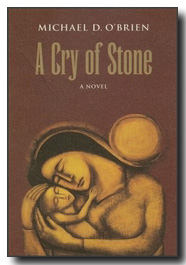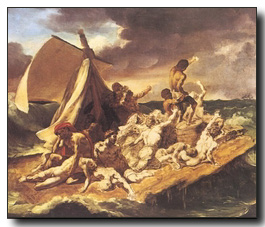A Rose Among Thorns
- ALBERT LOUIS ZAMBONE
In A Cry of Stone, the fifth novel in the series Children of the Last Days, Michael O'Brien has done his best work yet. This is a remarkable book.
 |
Beginning in 1996 with Father Elijah, Michael O'Brien a devout Roman Catholic; a Canadian; a painter and writer has been publishing a series of novels with the collective title, Children of the Last Days. Father Elijah is the story of Elijah Schafer, a Roman Catholic priest, a convert from secular Judaism, chosen by the power of the Holy Spirit to bring one last witness of God's mercy to the Antichrist himself. Set in the end of days, it finished with Elijah heading towards his prophesied martyrdom.
Due not only to the gravity of its themes but to its spirited writing, it was a tough book to follow with not just one but five others (O'Brien had projected both the number and subject of each of the novels from the beginning). O'Brien has been, in many ways, learning on the job. From the beginning he has been superb at forming full and powerful characters, with rich interior lives. And he has been simply unexcelled at writing about the importance of everyday life, unveiling for his readers the spiritual power of our simplest decisions and our casual commitments. O'Brien's focus on the spirituality of the everyday, not to mention his far superior writing, is what sets these books apart from dispensational novels like the Left Behind series-not to mention his very strongly held conservative Roman Catholicism, which is all-pervasive in his novels.
In A Cry of Stone, the fifth novel in the series, O'Brien has done his best work yet. This is a remarkable book, if for no other reason than for the wonderful and compelling character of its protagonist, Rose Wabos, an Ojibwa girl who grows into a solemn, winsome young woman in the course of the novel.
Born with a curved spine, abandoned by a mother she never knows, Rose is raised by her grandmother, Mary. Their love for each other is achingly described, and in a book filled with loves, theirs is perhaps most beautiful of all. They live in what can only be described as grinding poverty, but here O'Brien does one of the most wonderful things of the novel. While not pretending that their conditions are not miserable, he shows nonetheless their happiness without ever slipping into condescension.
O'Brien's great theme is the power of God seen in the weak. "Bent is the shape of love," Rose thinks once of her aging grandmother. The people around her who seem most straight turn out to be deeply twisted; and her bent spine holds together a vessel that brings grace and peace to those in need. But the actual pain that her deformed back gives her represses any pride that she might have in her brokenness. Her twistedness is not an accessory of virtue; it actually hurts, and makes her life one lived against a continual backdrop of ache, with spasms of agony.
 |
|
The Raft of Medussa
by Theodore Gericault (1819) |
Rose is an artist, and O'Brien has put a great deal of his artistic life in this book. It is not so much that he writes about pastels, oils, and the nature of tempera, though he does do that. The most important things he shares of his knowledge of art in A Cry of Stone are not techniques, but ways of seeing things. Rose from her childhood is blessed with a spiritual gift that she calls "falling into seeing," a prophetic knowledge of another person's heart. Her "falling into seeing" also enables her to see all the world around her as it actually is. In a wonderful scene when her painting class is studying the French artist Gericault's The Raft of Medusa, the following interchange occurs:
"It is as if the whole world is the sea," she said, "and the raft is the wreckage of a great ship that went down at the beginning of the world."The professor's eyebrows raised.
"Continue."
"We are the survivors."
Her ability to see is related to her striving for. She knows more of pain and of the bitter things of life than most do or would want to do. Nor are these things accepted as if they caused no hurt. Like her bent spine, the events of her life cause her pain and suffering. Throughout the novel O'Brien follows moments of sweetness in Rose's life with moments of hurt, pain, and despair. It sounds a bit like a soap opera, when put like that. But Rose is meant to be a servant of the King of Kings, and O'Brien does not spare his creation from the same way of pain that the king himself took when he came into his own creation, and it knew him not.
The Raft of the Medusa summarizes the difference between sacrificial suffering and the suffering that leads only to despair. Rose is delighted to learn that Gericault painted his powerful work to show the moment when the survivors of the Medusa saw the rescue ship approaching after they had endured weeks of unimaginable suffering. In like manner, she is able to endure her suffering because she trusts that the rescue attempt on Earth has already begun.
In this season of Epiphany, here is a book alive with wonder at the Incarnation of God and its powerful work in the life of believers. Here is a beautiful depiction of another rose growing up amidst the world's thorns.
![]()
|
A Cry of Stone |
|
|
From the Publisher Michael D. OBrien, artist, editor and author, is the highly regarded author of four best-selling novels including Father Elijah, Eclipse of the Sun, Strangers and Sojourners and Plague Journal.
OBrien takes the reader deep into the heart of a "small" person. There he uncovers the beauty and struggles of a soul who wants only to create, to help others to see what she sees. The story also explores the complex lies and false images, the ambitions and posturing that dominate much of contemporary culture, and shows how these have contributed to a loss of our understanding of the sacredness of each human life. Once again, Michael OBrien beautifully demonstrates that no matter how insignificant a person may be in the worlds eyes, marvels and mysteries are to be found in everyone. His central character, Rose, is among the despised and rejected of the earth, yet her life bears witness to the greatness in man, and to his eternal destiny. Order A Cry of Stone here. |
![]()
 This is Meaghen Gonzalez, Editor of CERC. I hope you appreciated this piece. We curate these articles especially for believers like you.
This is Meaghen Gonzalez, Editor of CERC. I hope you appreciated this piece. We curate these articles especially for believers like you.
Please show your appreciation by making a $3 donation. CERC is entirely reader supported.

Acknowledgement
Albert Louis Zambone. "Books & Culture's Book of the Week: A Rose Among Thorns." Christianity Today (January 26, 2004).
This article reprinted with permission from Christianity Today and the author.
The Author
Albert Louis Zambone is a D. Phil Candidate in Modern History at the University of Oxford. He lives in Virginia. One of his articles was recently published in The Best Christian Writing 2004.
Copyright © 2004 Christianity Today




